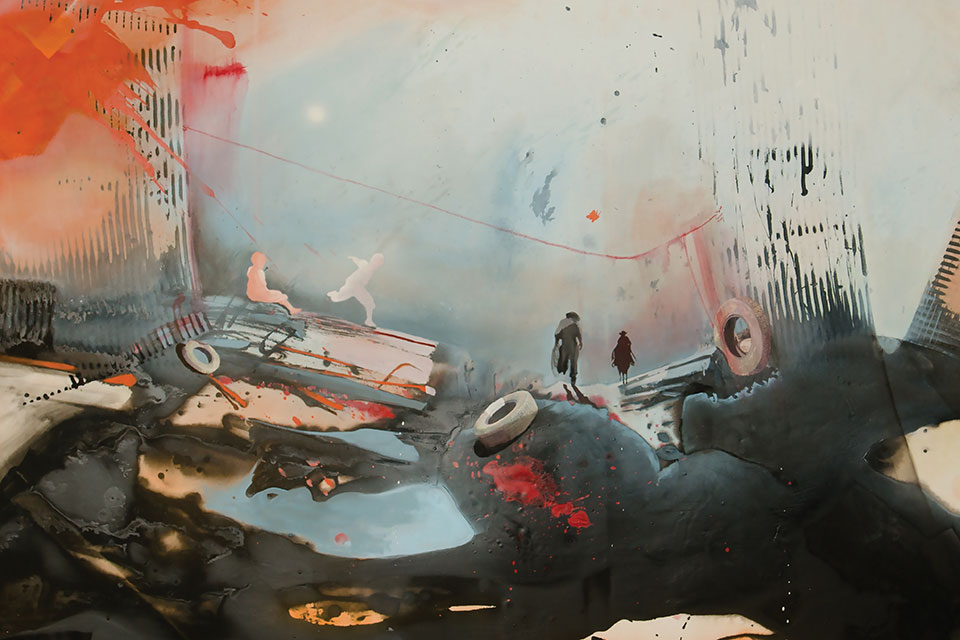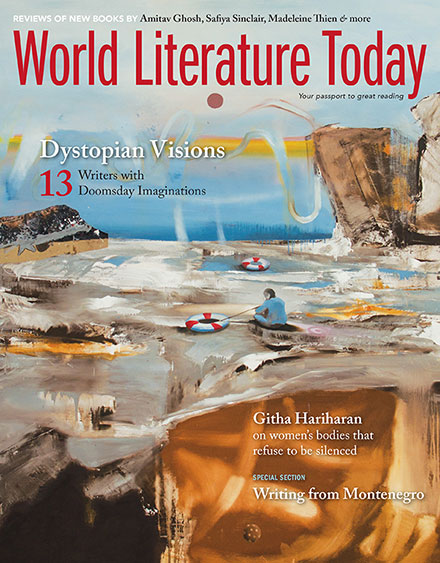Dead Reckoning: The Darkening Landscape of Contemporary World Literature

Dystopia, a dominant presence in contemporary literature, knows no cultural or geographic boundaries. Its dismal assessment of human potential reflects a growing loss of confidence in our global future.
Dystopia is a defining characteristic of contemporary world fiction. Revolution has given way to devolution. The reduction of the body and the spirit, material scarcity, erasure of memory, and challenges to individual and group identity increasingly displace the older narratives of struggle and success. Eroded hope in the power of individuals to influence vast global forces—changing climate, fraying alliances, migrating populations, rapidly advancing technologies—though not new in itself, has become increasingly dominant.
In Vasily Grossman’s Zhizn’ i sud’ba (1980; Eng. Life and Fate, 1985), a narrative of the battle of Stalingrad, when the generals look through their binoculars, all they see are toy soldiers fighting, the outcome as much a matter of luck as theory. To an old guard at the Stalingrad Power Station who refuses to leave his post, “the mounds of earth, heaps of twisted metal, damp acrid smoke, and the yellow reptilian flames of slowly burning insulators” represent what remains of his life. Grossman’s panorama of the clash of armies gives way to a microscopically detailed description of a German industrial turbine that combines the slaughterhouse with garbage incineration. Humanity’s organic matter flows down conveyor belts from the crematoria. After dentists have removed any precious metals, it is transformed by heat into phosphate fertilizer, lime, cinders, ammonia, sulphur gas, and carbonic acid. Everything will be used.
Contemporary world literature’s dark dystopian vision crosses cultural and geographic boundaries. The tone may be elegiac, as in Jeet Thayil’s Narcopolis (2012), set in a decaying sector of Bombay, or brutal, as in Hassan Blasim’s The Corpse Exhibition and Other Stories of Iraq (2014), set in a war-torn country in the Middle East. In Thayil’s novel, a man castrated at nine serves addicts in a drug den, never knowing that right outside the streets are bombed and pedestrians scramble over rubble. In Blasim’s title story, artists compete to stage dead bodies in aesthetically pleasing ways, carefully posing an intact mother and child or rearranging body parts for maximum effect, but it is difficult to engage anyone’s attention. László Krasznahorkai’s Az ellenállás melankóliája (1989; Eng. The Melancholy of Resistance, 2000), a masterful work that chronicles the destruction of a village after a Walpurgisnacht of rioting and mayhem, shows that once broken, these worlds cannot be easily reassembled.
Whether down dark alleys and streets, in the landscapes of urban decay, or in the withered fields of a ruined nature, the obstacles to survival proliferate until their very descriptions strain the limits of language. Realism alone cannot convey the horror, so dystopian authors commonly employ the grotesque. In Krasznahorkai’s village, youths swagger around punching old ladies. Feral cats hunt humans on sidewalks strewn with glass and garbage; crowds rampage, hypnotized by the chirping of a shrunken puppet-man sitting in front of a rotting whale. The villagers, crushed, their homes destroyed, awake to new laws made by violent men. A nameless thug who facilitated the attack, leading the mob to rape and pillage, is now charged with keeping security.
Dystopias may occur suddenly, as Mario Vargas Llosa demonstrates in his Fiesta del chivo (2000; Eng. The Feast of the Goat, 2001), about the rise of the Dominican dictator Rafael Trujillo, or they may develop more slowly. Ludmilla Petrushevskaya’s scary fairy tales recount the unending suffering of the Stalinist and post-Stalinist period. Those who survive the successive purges cannot find out why they were arrested and tortured because their faces have been cut out of photographs and their names torn out of books. In these stories, only black humor can convey the pain of a family under siege, when adultery and drunkenness disable all relationships. Husbands flee, wives bear unequal burdens, children abandon aging parents. Work provides neither security nor satisfaction. Apartments are fought over viciously, sold out from under their tenants, often by relatives.
Out of this same madness and hysteria comes Petrushevskaya’s There Once Lived a Woman Who Tried to Kill Her Neighbor’s Baby (2009). Her narrative of end times, the title of which literally reads, “The New Robinson Crusoes: A Chronicle of the End of the Twentieth Century,” undermines Daniel Defoe’s novel of self-sufficiency, self-discovery, and salvation. How could utopia fail?
In Petrushevskaya’s version, the father of a family of three senses the looming catastrophe long before it arrives. Over the years, he collects canned goods and packets of soup to feed his family until they can begin to farm. They leave the city in a hurry, saying goodbye to no one, estranged from grandparents over claims to an apartment. They move to their holiday cabin hidden in a remote forest. The tumbling ruble turns them to bartering. But the manufactured food traded for goat’s milk soon runs out. Recent history surfaces when old grievances from the period of collectivization erupt among the peasant women. A neighbor reveals she learned her nursing skills in the Kolyma labor camp.
The family returns to a pre-industrial past. They begin subsistence farming, hoping that productivity will help them live another day. They take stock; like Crusoe, they make lists and check off items. Only their neighbor, Baba Anisya, ever actually walked behind a plow. Her memory is essential. The family must go on even after the suicides of two elderly people: Marfutka, who decides to starve to death, and Vera, a shepherdess without sheep who hangs herself.
In a dystopia, when time has run out and the worst is yet to come, the urge to live still remains.
In a dystopia, when time has run out and the worst is yet to come, the urge to live still remains. Like Crusoe, they measure and plan, building shelters and stewing grasses, mushrooms, berries, and potatoes. In an abandoned shed they find pickled apples, cucumbers, and tomatoes. Calluses grow on their hands. But unlike Crusoe, who can adapt and even thrive, hard work will not suffice. Luck alone rules in this new world.
In Petrushevskaya’s parable of Russia’s collapse, a family lies in wait with a rifle, skis, and a smart dog. Citizens vanish when the state disappears them. In Daniel Alarcón’s Lost City Radio (2007), a prison called the Moon effectively stifles dissent. Once inside, political prisoners rarely emerge intact. Only Lost City Radio names them, and others, engulfed by the ever-expanding slums or buried in a mysterious and dangerous interior teeming with informers and disinformation. There is an official list of the missing and another, secret, one.
Through the lens of a few characters, Alarcón narrates the tumultuous recent history of Peru, in which tens of thousands died and hundreds of thousands more were displaced. For a decade, the government wages war in the city and the jungle against the IL—the Illegitimate Legion. After guerilla bombings, the state razes whole neighborhoods. The government wins a victory that leaves the city in ruins. Guerrillas, unmoored from their leaders, continue to fight for years. In the vast and unmapped interior, the government changes the names of villages to numbers. The old languages die with their speakers. Memory has never been so important nor so tenuous. Alarcón has written that Peru suffers from a collective amnesia about the past, that individuals, societies, and nations all shrink from remembering trauma. When forgetting becomes a state religion, the past becomes subversive.
At the beginning of the war, Rey, then a student who had led a few campus demonstrations, is taken off a bus at a roadblock and put into the Moon for a year. Once freed, although physically altered by torture and shaken by frequent nightmares, he returns to the IL as a courier in a network of ex-prisoners and insurgents. Three years into the war, he writes a controversial article that refuses to condemn tadek, an ancient, arbitrary, and cruel practice of justice he witnessed as a botanical anthropologist during annual visits to the interior. He claims that the indigenous people needed to begin performing this ritual again as a way of mirroring the reasoning of the state.
In tadek, when a crime is committed, a child, dazed and drunk from a potent tea, walks inside a circle of villagers, finally seizing on someone, anyone, drawn perhaps by a flash of color or the pattern on a piece of cloth. That person is then led away to have his or her hands removed. Rey argues that this ritual parallels the state’s own practice of justice. Since the state imprisons thousands using outward signifiers of age, occupation, and social status as “evidence,” the villagers should feel empowered to practice an equally random way of assigning guilt. On the basis of fabricated evidence, Rey himself will be murdered.
Dystopia demands the personal diminishment of the individual. It thrives on the erasure of identity, on fear, forgetting, hopelessness, terror, and irrationality, on creating material scarcity, damaging civility, and eliminating empathy. The characters of contemporary dystopian world fiction inhabit a world without history or social cohesion.
Bethlehem, Pennsylvania












